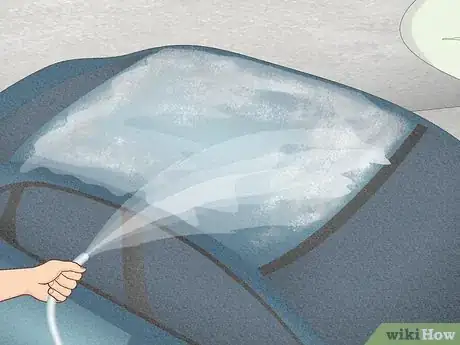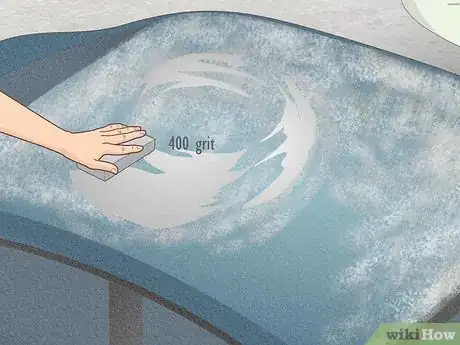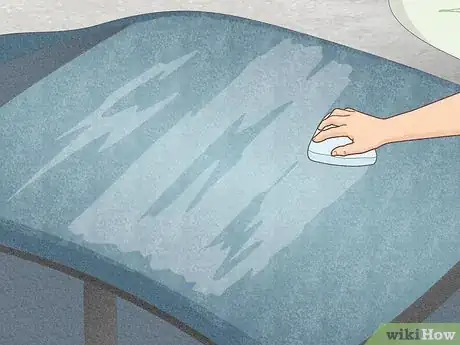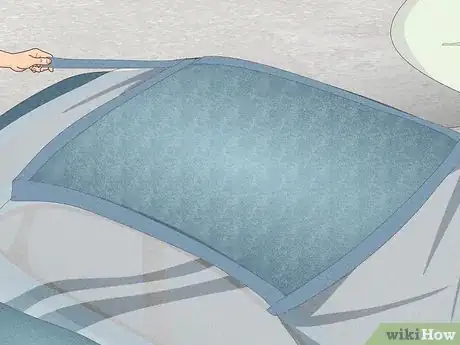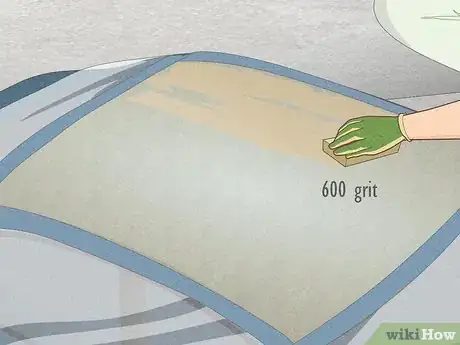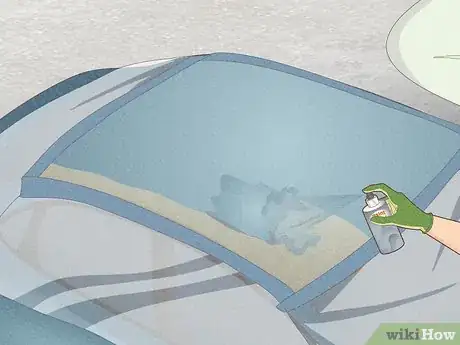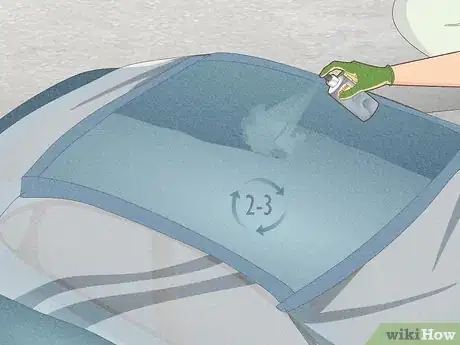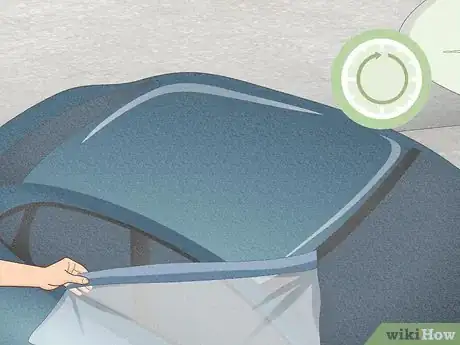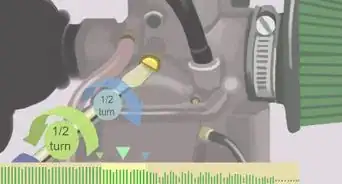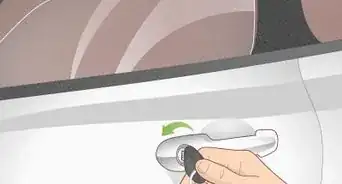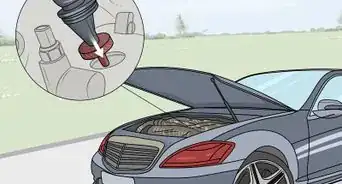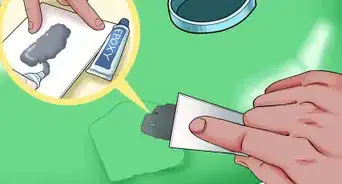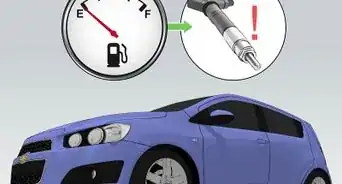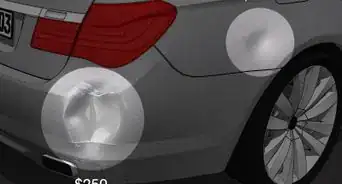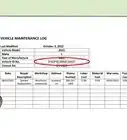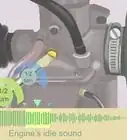This article was co-authored by Chad Zani and by wikiHow staff writer, Christopher M. Osborne, PhD. Chad Zani is the Director of Franchising at Detail Garage, an automotive detailing company with locations around the U.S. and Sweden. Chad is based in the Los Angeles, California area and uses his passion for auto detailing to teach others how to do so as he grows his company nationwide.
There are 16 references cited in this article, which can be found at the bottom of the page.
This article has been viewed 27,375 times.
If you’re looking to paint your car yourself and get exceptional results, it’s a must to invest in a pro-style paint sprayer and use expert techniques. Since your car’s roof is less noticeable, though, you may decide it’s okay to settle for “pretty good” results instead. In this case, opt for the easier and cheaper alternative of using “rattle can” automotive spray paints. But don’t skimp on the prep work!
Steps
Prepping the Roof for Painting
-
1Match the existing color by using the car’s color code to buy paint. If, for example, your car is currently blue-grey and you want the repainted roof to remain that color, find your vehicle’s paint color code. It’s usually listed on the “compliance plate” under the hood, which also includes details like the VIN number. Write down this code and bring it to an auto paint retailer to get a color match.[1]
- The color code is sometimes also included on the driver’s side door frame, in the same spot where the tire pressure recommendations are listed.
- If you’re looking to paint your roof a different color—black is a popular choice, for instance—go ahead and pick out any color you like!
- You can also buy color-matched auto paint from several online retailers. Enter your car’s make, model, year, and paint code to order the paint.
- In addition to “rattle cans” (spray cans that rattle when you shake them) of color-matched automotive paint, you’ll also need rattle cans of automotive primer and automotive clear coat finish.
-
2Put on a respirator and personal safety gear for any car painting job. It doesn’t matter whether you’re using a compressed air sprayer or a rattle can of spray paint: automotive paint contains chemicals that you don’t want to breathe in or absorb into your skin. For your safety, put on a respirator mask (not just a dust mask) and wear goggles, long sleeves and pants, and gloves.[2]
- For even greater protection than your long sleeves and pants can provide, put on a disposable full-body protective suit with a hood.
Advertisement -
3Work in a well-ventilated garage or a covered outdoor spot. In addition to a respirator and safety gear, good ventilation is critical when using automotive paints. In a home setting, a highly-ventilated garage is usually the best option. However, do not use spray paint in your garage if it contains a water heater, furnace, or other potential source of ignition.[3]
- At the very least, keep the main garage door and another exterior door or window open. For additional ventilation, set up fans to both draw in and exhaust air. You’ll also need to put up lots of plastic sheeting to protect your stuff from paint overspray.
- If you need to paint out in the open, set up a canopy tent over your car to protect your work from sunlight, raindrops, leaves, twigs, and so on.[4]
-
4Wash and rinse your car’s roof, then let it air dry. Use a regular automotive soap, water, and a sponge or microfiber cloth to clean off all visible dirt, dust, and debris. Rinse the area thoroughly with clean water when you’re done. Wait for the roof to air dry before proceeding—don’t use a towel since this may leave lint on the surface.[5]
- Don’t apply any wax—you need to remove as much wax as possible before painting!
-
5Get rid of any rust spots with sandpaper or a grinder. For smaller rust spots, use a sanding block with 180-grit sandpaper. For extensive rusting, use a metal grinder to remove as much rust as you possibly can. If you end up with some small holes, use a putty knife to fill them with a non-rusting auto body filler, then let the filler dry completely before proceeding.[6]
- Whether you’re using a sanding block or a metal grinder, make small circular motions to remove the rust.
-
6Sand the whole roof with a 400-grit block so it accepts primer better. Apply firm but even pressure with your hand and sand in small circles. Use a spray bottle to wet down the area you’re sanding; alternatively, poke a hole in the cap of a plastic bottle so you can squeeze water out of it.[7] To speed up the process slightly, use a 320-grit sanding block instead.[8]
- You’ll get the best paint job by sanding down to bare metal, but that isn’t really necessary when painting your roof with a rattle can. Just aim to sand off all the existing clear coat finish. The entire roof should have a dull finish when you’re done.
- If you do sand down to bare metal anywhere, “feather” the paint surrounding it. Apply more pressure at the bare metal and less as you move away to smooth out the difference in paint depth.[9]
-
7Clean the roof thoroughly with wet rags, tack cloths, and then a degreaser. When you’re done sanding, wipe down the roof with a few damp rags. When the roof dries, wipe it with a tack cloth to remove any remaining dust from sanding. Finally, wipe down the entire roof with clean rags and a commercial degreaser—use it according to the product instructions.[10]
- Mineral spirits, paint thinner, or denatured alcohol can be substituted for the degreaser. But choose only one and never combine products, or you may create dangerous fumes.[11]
-
8Protect the areas you don’t want to paint with tape and paper or plastic. Carefully apply painter’s tape around the edges of the roof, pressing it down firmly into the seams between the roof and the doors, front windshield, and rear windshield. Use more tape to apply plastic sheeting or contractor’s paper over the doors, windshields, front hood, and trunk. The more you cover up, the better![12]
- If you have a sunroof, take your time and be sure to cover it completely. Press the tape down into the seams around the edges—otherwise you might paint it shut!
Applying Primer, Paint, and Clear Coat
-
1Spray on 3 light, even coats of automotive primer. Shake the can vigorously for at least 1 minute, and for up to 4 minutes—make sure it rattles! Hold the can about 12 in (30 cm) from the roof surface and spray in steady, even blasts, moving the can from from side to side. Start at the side of the roof that’s furthest from you and work your way to the other side in parallel lines. Wait 20 minutes, add a second coat, then wait another 20 minutes before adding the third coat.[13]
- Adding multiple light coats produces superior results as compared to putting on a single heavy coat. Be patient!
- Practice your spraying technique now, so that it’s perfected when you add the color coats and clear finishing coats.
-
2Sand the primer lightly with a 600-grit block, then wipe the dust. Once the last primer coat dries completely, sand it gently with a 600-grit sanding block. Instead of making small circles this time, however, sand in long, even strokes, always going in the same direction. Wipe off the dust with a clean, damp rag, let the roof dry, and then wipe it again with a tack cloth.[14]
- Sand very lightly here! The goal is to even out the primer and lightly etch it so it holds the finish coats better.
-
3Spray on a light coat of your chosen color of rattle can auto paint. Use the same technique as with the primer: make long, steady, even, parallel strokes from the far side of the roof to the near side. Make this first coat very light, though—you should still clearly see the coloring of the primer coats beneath the surface. Let the paint dry for 20 minutes before proceeding.[15]
- Wipe down the surface with a tack cloth after this first coat dries. In fact, use the tack cloth after each coat you apply from now on.[16]
-
4Add a second and third coat of paint to get a full, even color. Use the same technique to apply the second coat, but make it a somewhat heavier coat—by the time you’re done, the primer color should be barely visible. Let the coat dry and then wipe it down with a tack cloth. When you apply the third and final coat, focus on evening out the coverage—make the coat a bit heavier where the primer is barely visible and lighter where the coverage is already good.[17]
- Use the tack cloth again after the third coat. If you’re still not completely satisfied with the evenness of the coverage, go ahead and add a fourth coat.
-
5Apply 3 layers of rattle can automotive clear coat. Use the same techniques as you did with the colored auto paint. Start by spraying on a light first layer of clear coat, using long, even, parallel passes. Wait about 20 minutes for it to dry, then wipe down the roof with a tack cloth. Add a second, heavier layer, wait and wipe, and then apply a third layer to even out the glossy finish.[18]
- It’s okay to add a fourth or even fifth layer of clear coat if you haven’t quite gotten the even, glossy finish you desire.
-
6Wait at least 12 hours before removing the painter’s tape. Give the clear coat time to cure before carefully pulling away the painter’s tape and any plastic sheeting or contractor’s paper. Allow the clear coat to cure for at least another 12 hours, and ideally for up to 7 days, before exposing the car to the elements.[19]
Things You’ll Need
- Respirator mask
- Goggles
- Gloves
- Automobile primer
- Automobile paint
- Automobile clear coat
- Tack cloths
- Clean rags
- Spray bottle
- Sanding blocks (180-, 400-, and 600-grit)
- Painter’s tape
- Plastic sheeting or contractor’s paper
References
- ↑ https://www.autobodytoolmart.com/how-to-paint-a-car-t.aspx
- ↑ https://www.osha.gov/SLTC/etools/shipyard/standard/ppe/operations/ppe_painting.html
- ↑ https://www.hotrod.com/articles/ccrp-1107-home-garage-paint-booth/
- ↑ https://youtu.be/BpMCgiw-AJk?t=30
- ↑ https://www.autopartspro.co.uk/tips-advice/how-to-paint-a-car-yourself-542
- ↑ https://garage.eastwood.com/eastwood-chatter/paint_your_car/
- ↑ https://youtu.be/_owAbAw7FSE?t=60
- ↑ https://youtu.be/BpMCgiw-AJk?t=60
- ↑ https://youtu.be/_owAbAw7FSE?t=75
- ↑ https://www.autopartspro.co.uk/tips-advice/how-to-paint-a-car-yourself-542
- ↑ https://www.popularmechanics.com/cars/how-to/a3110/a-diy-guide-to-painting-your-car-15998013/
- ↑ https://youtu.be/MvL9TqeXJZ4?t=105
- ↑ https://www.hagerty.com/media/maintenance-and-tech/rattle-can-diy-paint-job/
- ↑ https://youtu.be/_owAbAw7FSE?t=240
- ↑ https://youtu.be/_owAbAw7FSE?t=465
- ↑ https://www.hagerty.com/media/maintenance-and-tech/rattle-can-diy-paint-job/
- ↑ https://youtu.be/_owAbAw7FSE?t=540
- ↑ https://youtu.be/_owAbAw7FSE?t=570
- ↑ https://www.hagerty.com/media/maintenance-and-tech/rattle-can-diy-paint-job/



